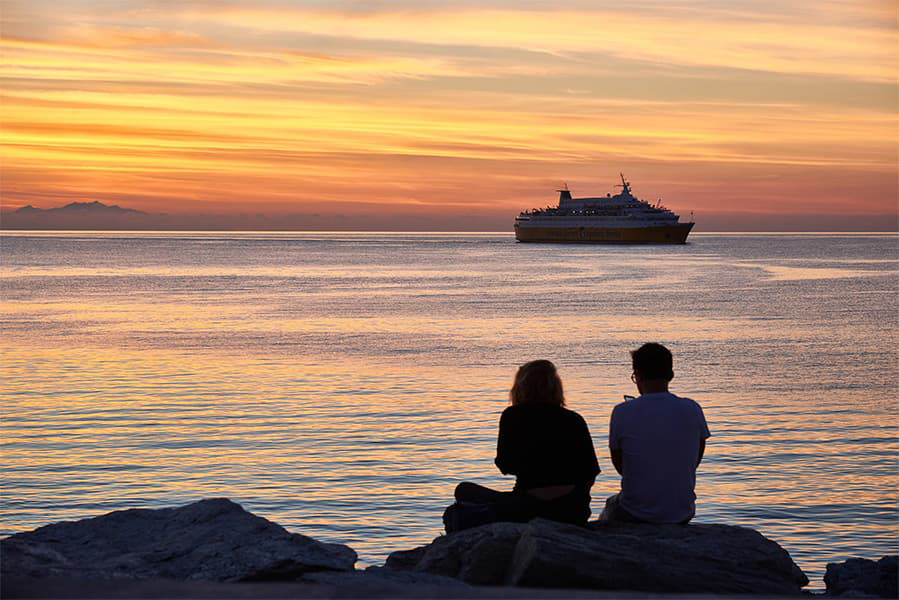Symi (Simi) – Agios Kirikos
Ferry to Ikaria
Symi (Simi) – Agios Kirikos
Ferry to Ikaria

provides the ferry from Symi (Simi) to Agios Kirikos. Symi (Simi) Agios Kirikos ferries cost between £32 and £120, depending on ticket details. Prices exclude any service fees. Ferry timetables change seasonally, use our Deal Finder to get live pricing and availability for Symi (Simi) Agios Kirikos ferries.
The first Symi (Simi) Agios Kirikos ferry typically departs from Symi (Simi) at around 17:20. The last ferry usually departs at 17:50.
The Symi (Simi) Agios Kirikos ferry trip can take around 10 hours 35 minutes. The fastest sailings are approximately 9 hours 50 minutes with . Sailing times can vary between ferry operators and can be impacted by weather conditions.
There is 1 weekly sailing from Symi (Simi) to Agios Kirikos provided by .
Symi (Simi) Agios Kirikos ferry prices typically range between £32* and £120*. The average price is typically £47*. The cheapest Symi (Simi) Agios Kirikos ferry prices start from £32*. The average price for a foot passenger is £47*.
Pricing will vary depending on number of passengers, vehicle type, route and sailing times. Pricing is taken from searches over last 30 days and exclusive of service fees, last updated August 25.
The distance between Symi (Simi) to Agios Kirikos is approximately 123.2 miles (198.3km) or 107 nautical miles.
No, ferry operators currently do not allow cars to travel on sailings between Symi (Simi) and Agios Kirikos.
No, currently ferry operators do not allow foot passengers to sail between Symi (Simi) and Agios Kirikos.
Pets are currently not allowed on board the ferries from Symi (Simi) to Agios Kirikos.
More routes than anyone else.

Compare fares, times & routes in one place.
Change plans easily with flexi tickets.

Book e-tickets & manage trips in-app.
Live ship tracking & real-time updates.

Top-rated customer support when you need it.
The Greek island of Symi is one of the Dodecanese Islands and is located around 40 km to the north west of the island of Rhodes and 420 km from the Port of Piraeus. Symi's closest neighbours are the Datca and Bozburun peninsulars of Mugla Province in Turkey. The island's terrain is mainly mountainous and its coastline is made up of either beaches and secluded coves, or rocky cliffs. Located on the north east coast of the island is its main town, also called Symi. The lower town is the area around the harbour, called Yialos, and the upper town is called Horio or Ano Symi. There isn't a great deal to see or do on the island, and this is perhaps where its charm is. Apart from lazing on the beach or swimming in its crystal clear waters the Monastery of the Archangel Panormitis, which is an early 18th century Greek Orthodox monastery built on the coast in the south west of the country, is worth visiting. Overlooking Ano Symi is the Kastro which was built by the Knights of St. John as an expansion of a Byzantine castle on the same site. Quite a bit of the structure remains and there are also signs of an ancient citadel on which two later castles were built.
The town of Agios Kirykos is located on the Greek island of Ikaria which lies in the North Aegean Sea. Many sailors and captains built their houses in Agios Kirykos, which is the island's capital, which gave the town a very nautical feeling. Many of the exhibits on display in the archaeological museum have been recovered from the sea bed and therefore the nautical theme continues. The sea around the island, according to myth, is where the son of Daedalus landed when the sun burn his wax wings and that the islet of Nikari, opposite Agios Kirykos, is the resting place of Ikarus.
The island's terrain is mainly mountainous and covered by Cypress, Plane, Oak and Pine trees. The tree coverage on the island enable the ground to retain moisture which in turn enable wild goats to graze. The forest of Radi, part of the Natura 2000 scheme, is considered to be the oldest in the Balkans. Low types of oak trees are its most numerous “residents”.
The island is accessible by boat from the port of Piraeus and Kavála, in the north of the country.